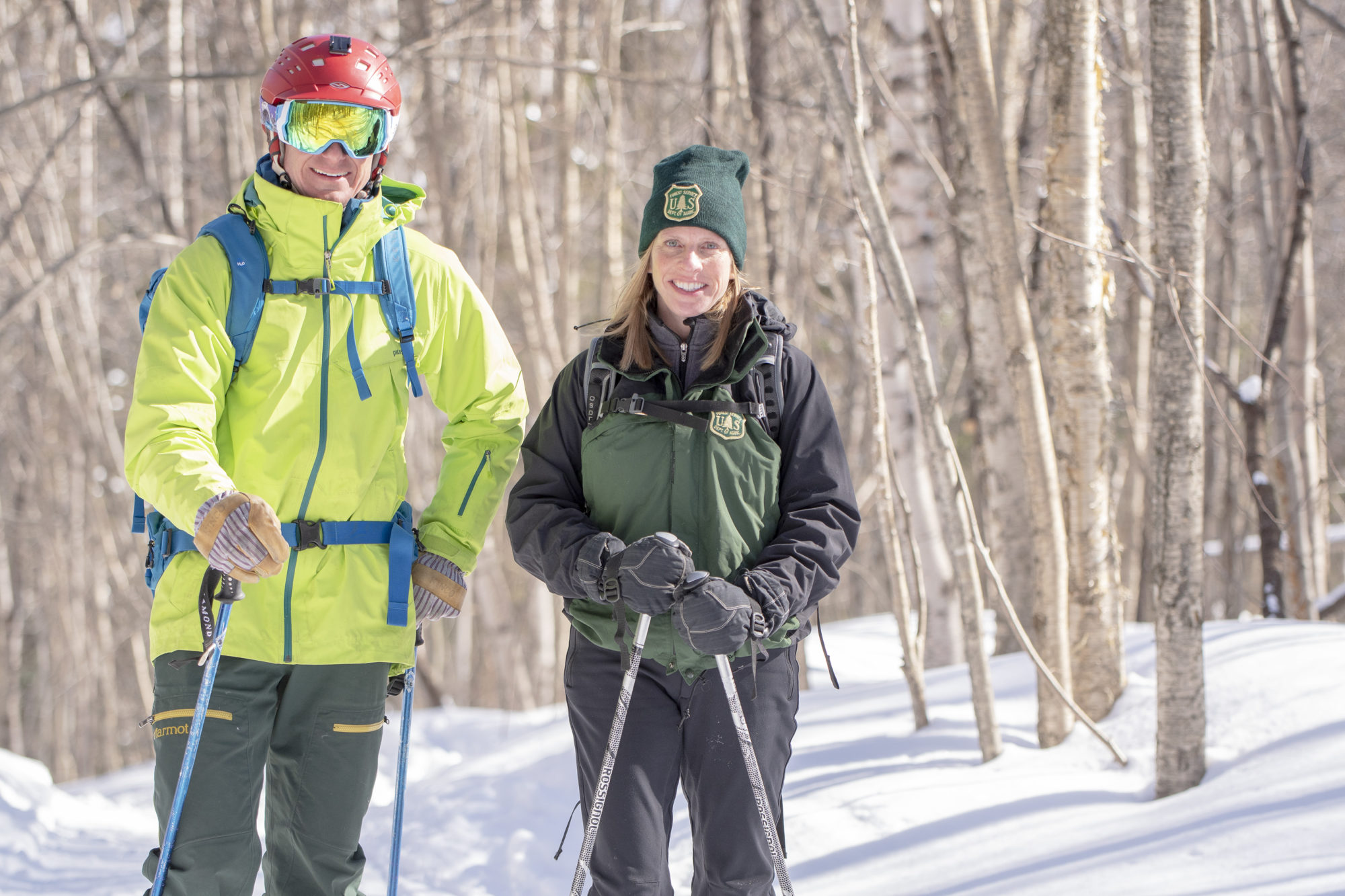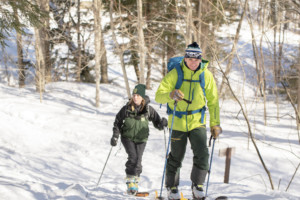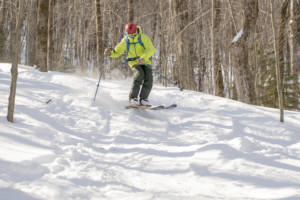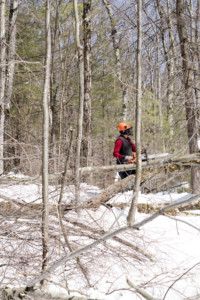Ski the Trees, Protect the Forests
March 15, 2019

By Christine McGowan, Forest Program Director, Vermont Sustainable Jobs Fund
Skiing backcountry terrain in Vermont is hardly a new idea. Originally a mode of transportation for Vermonters stranded by unpassable, snow-covered roads, skiing in the woods dates back to the early 1900s when visitors from Norway introduced the novel idea of strapping long, wooden slats to your boots to move more easily through the snow. Vermont’s steep, mountainous terrain and plentiful snowfall proved the perfect natural conditions for the sport to thrive and a winter tourism economy was born, bringing with it rope tows, chair lifts and resorts.
Despite the growth of Vermont’s ski industry, however, there remain those who prefer to “earn their turns” in the woods, choosing old logging trails over busy resorts. In recent years those numbers have increased, to the point that illegal trail cutting has caught the attention of public land managers charged with managing Vermont’s forest health.
“Recent surveys taught us that a number of backcountry skiers still do not believe that clipping lines is a concern; collectively, however, it can negatively impact forest health,” said Holly Knox, a recreation program manager for the Rochester and Middlebury Ranger Districts in the Green Mountain National Forest. “Even minimal clipping can impact the forest understory in structure and composition; as forest structure is reduced, stands can become highly susceptible to wind throw, insect and disease affliction, and other events that can dramatically affect the forest.”
Knox and others, however, see managing backcountry skiing as more of an opportunity for Vermont’s forests than a threat. “Forests can be managed for multiple uses including recreation if we balance ecological, economic and social concerns,” said Knox. With the sport growing but still in its fledgling years, leaders in both the forest and recreation industries are looking at collaborative efforts in communities such as Rochester, Willoughby and Readsboro as potential models for increasing access to the backcountry, while simultaneously protecting and restoring the environment on which the sport depends.
Silviculture with Skiing in Mind
With a report by the Winter Wildlands Alliance predicting that “undeveloped skiing” will be one of the top five growth activities over the next several decades, Michael Snyder, a forester, avid backcountry skier, and the Commissioner of Vermont’s Forests, Parks and Recreation Department, is considering the state’s role in expanding access to the sport. “Managing forests for recreation is not new,” said Snyder. “Cross-country skiing has co-existed with forestry for decades. What’s new is taking an intentional approach to managing the woods specifically for backcountry skiing.”
For starters, Snyder is aiming to develop a handbook for foresters that will outline considerations for silviculture treatments specific to backcountry ski zones, such as restoration of past illegal cutting, conservation of wildlife habitat, planned timber harvests for stand improvement and regeneration, safe and accessible parking areas, and the opportunity for logging trails to be used for uphill skin tracks. The most coveted backcountry terrain typically includes steep, higher-elevation areas not suitable for logging, but a comprehensive plan would take into account the lower-elevation timber harvests below those lines. Glade skiing terrain, which might be spread over dozens of acres, also requires different considerations than a single, point-to-point cross-country or mountain biking trail.
Snyder is also considering a pilot program on state lands and looking to existing projects as models. “As a skier and a forester, I can’t help but look around the forest and think about what could be,” said Snyder. “Especially when we look at these new backcountry ski zones through the larger lens of economic development in rural areas and in conjunction with forest management.”
According to a 2013 study on the Economic Importance of Vermont’s Forest Based Economy, forest-based recreation is one of Vermont’s most valuable assets, annually contributing $1.9 billion and 10,000 jobs to Vermont’s economy. Established trail systems, such as the Kingdom Trails in Burke, have demonstrated the kind of economic impact forest recreation can bring to rural areas, both in the form of tourism and forest industry jobs, and Snyder is optimistic that towns with emerging backcountry zones could see an economic boost as well. “A well-planned backcountry zone in Vermont’s smaller, more rural areas, such as Willoughby, Westmore, Averill, Montgomery, or Plymouth, for example, might be enough to move the economic needle,” he said.
Brandon Gap, A Model for Collaboration

Angus McCusker, one of the founders of the Rochester/Randolph Area Sports Trail Alliance (RASTA) and Holly Knox, a recreation program manager for the Rochester and Middlebury Ranger Districts in the Green Mountain National Forest, skin the hills of Brandon Gap. The two have an easy rapport and share a passion for back-country skiing and the wilderness. Photo by Erica Houskeeper.
If the Brandon Gap backcountry zone is any indication, Snyder is onto something. One of the state’s first backcountry ski zones and part of the Rochester/Randolph Area Sports Trail Alliance (RASTA), Brandon Gap had 3,628 skier visits during the 2017/2018 ski season, generating $2.1 million in sales at local restaurants, bars, lodgings, gas stations, and retail shops. On February 18, 2017, an epic powder day, the area saw 171 visitors who generated just under $200,000 in sales. The economic impact study, which was conducted by the SE Group, also estimates that visitor spending correlates to 34 new, full-time equivalent, tourism-related jobs. The numbers, however, only tell part of the Brandon Gap story.
“The underlying reason for creating these backcountry zones is enjoyment for all,” said Angus McCusker, one of the founders of RASTA. “We have this incredible resource in the green mountains and we love to ski. Every few years, a logging operation would come through and leave a perfect trail, but as the understory grew back we’d have to find a new spot. We thought, ‘let’s get organized and do this right so the trails will last.’” McCusker and others hosted Vermont’s first backcountry forum in 2013, inviting a panel of foresters, private landowners, and state and federal officials (including Michael Snyder and Holly Knox) to gain an understanding of how best to proceed.
“Working closely with land managers, such as the USFS, gave us insight and the opportunity to work with a team of scientists including biologists and silviculturists who look at the forest through a different lens,” said McCusker. “It gave us all a much better understanding of the impact we have on the overall health of the forest.” Working within a comprehensive forest management plan, RASTA organized a volunteer day in the Braintree Mountain Forest, a popular backcountry area, to trim low branches and clear out some understory growth. “A lot of people came out,” recalled McCusker, “and one of the foresters commented that we were providing free timber stand improvement or ‘TSI’. I realized we were working within their plan to manage the forest for long-term health and also achieving our own objectives.”
Dutch Hill, Reopening Vermont’s Lost Ski Areas
Further south, in Readsboro, a similarly collaborative effort has reopened the Dutch Hill Ski Area. Originally a lift-served ski area that opened in 1944, Dutch Hill had been closed to the public since 1985. Like RASTA, The Dutch Hill Alliance of Skiers and Hikers (DHASH) worked with staff from the Green Mountain National Forest to develop a forest management plan that included re-opening the Dutch Hill trails, restoring areas that had been damaged by unregulated off-road vehicle use, and enhancing wildlife habitat. The area was reopened to the public for hiking, skiing, splitboarding, and sledding in 2017.
“Old trails were in various stages of reverting back to forest and in some places, non-native invasive species had moved in,” said Jeff Tilley, a silviculturist and forestry program leader with the Green Mountain National Forest. “Working with recreation interests, we formed an interdisciplinary team that looked holistically at how the landscape could be managed, improved and restored.”
Among the main components of the plan, the forested areas of Dutch Hill are now being actively managed for wildlife habitat, timber production, and the maintenance of open, grassy areas for hiking and skiing. Timber production is not a primary focus, however, Tilley is planning a harvest to remove approximately 2 million board feet of primarily low-grade wood appraised at around $70,000. The harvest will be offered as a stewardship contract, where the purchaser will exchange work for the wood, and all revenue will be reinvested in restoration and regeneration treatments on the site, including erosion control, soil stabilization, interpretive signage, and wildlife openings. Timber harvests create jobs in the region with estimates varying from 22 to 32 full-time jobs per million board feet, according to Tilley.
“The project is an opportunity to demonstrate how sound, sustainable forestry can not only be compatible with backcountry recreation, but can provide opportunities to enhance it as well.” said Tilley.
Backcountry ski enthusiasts are hopeful that Dutch Hill can serve as a model for the state’s “lost ski areas,” small and mid-sized ski areas that have been closed for decades. According to the New England Lost Ski Areas Project, there are more than 120 lost ski areas in Vermont, including eight that have been reopened for winter recreation.
The Future of Backcountry Skiing in Vermont

Angus McCusker, one of the founders of the Rochester/Randolph Area Sports Trail Alliance (RASTA) backcountry skis in Brandon Gap’s Bear Brook Winter Access Area. Photo by Erica Houskeeper.
What might the future of backcountry skiing in Vermont look like in the next decade? McCusker thinks we are “pretty damn close” to the dream of vibrant, community-based backcountry zones that provide access to a sport once considered renegade. He notes projects being discussed to introduce beginner terrain, the creation of a hut-to-hut system, and an effort to introduce more youth to the sport. More access to the backcountry, however, remains his primary goal. “The true backcountry experience is spread out, not limited to small, condensed areas and more terrain means more un-skied powder, which is what many backcountry skiers are really after out there.” McCusker would like to see more people getting out into the woods, away from lift lines and resorts. “It’s a purer experience that helps people learn to be better stewards of the land. Resort skiing is prohibitively expensive for a lot of people, but the backcountry is free and accessible to everyone.”
Michael Snyder agrees. “Where we can develop and leverage our natural, recreational assets for economic growth, we can also bring health, wellness, and a sense of community to rural parts of Vermont, all while maintaining a healthy working forested landscape,” said Snyder. “Skiing in the forest is part of our tradition and culture and, let’s face it, Vermont winters are still too long not to get out there and enjoy it.”
For more information on backcountry skiing, check out the Catamount Trail Association with its grassroots chapters and program areas such as the Vermont Backcountry Alliance.
About the Vermont Forest Industry Network
The Vermont Forest Industry Network will host the 2nd Annual Vermont Forest Industry Summit on May 2-3, 2019 at Burke Mountain Resort. Vermont’s forest products industry generates an annual economic output of $1.4 billion and supports 10,500 jobs in forestry, logging, processing, specialty woodworking, construction and wood heating. Forest-based recreation adds an additional $1.9 billion and 10,000 jobs to Vermont’s economy. The Vermont Forest Industry Network creates the space for industry professionals from across the entire supply chain and trade association partners throughout the state to build stronger relationships and collaboration throughout the industry, including helping to promote new and existing markets for Vermont wood products, from high quality furniture to construction material to thermal biomass products such as chips and pellets. For more information please visit www.vsjf.org.





